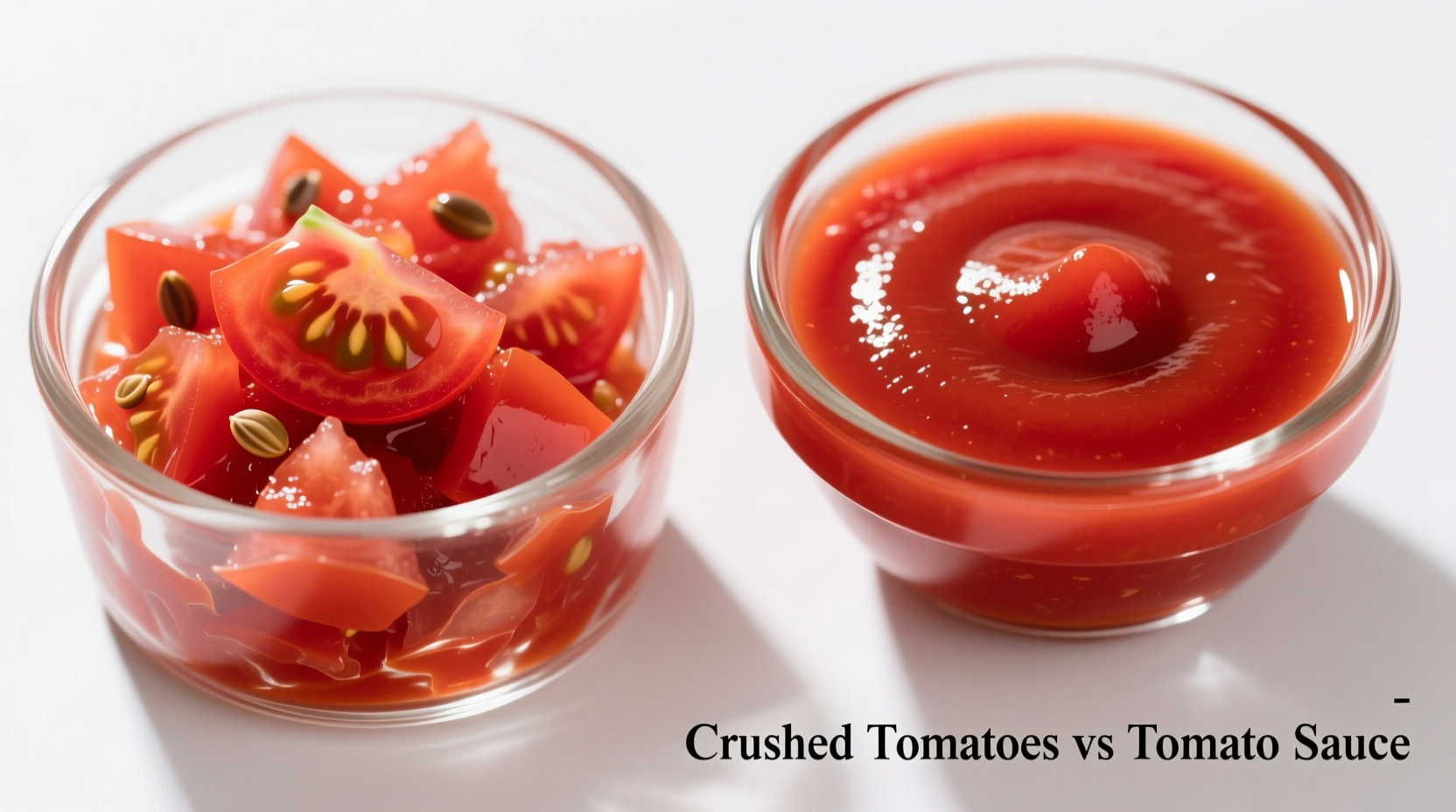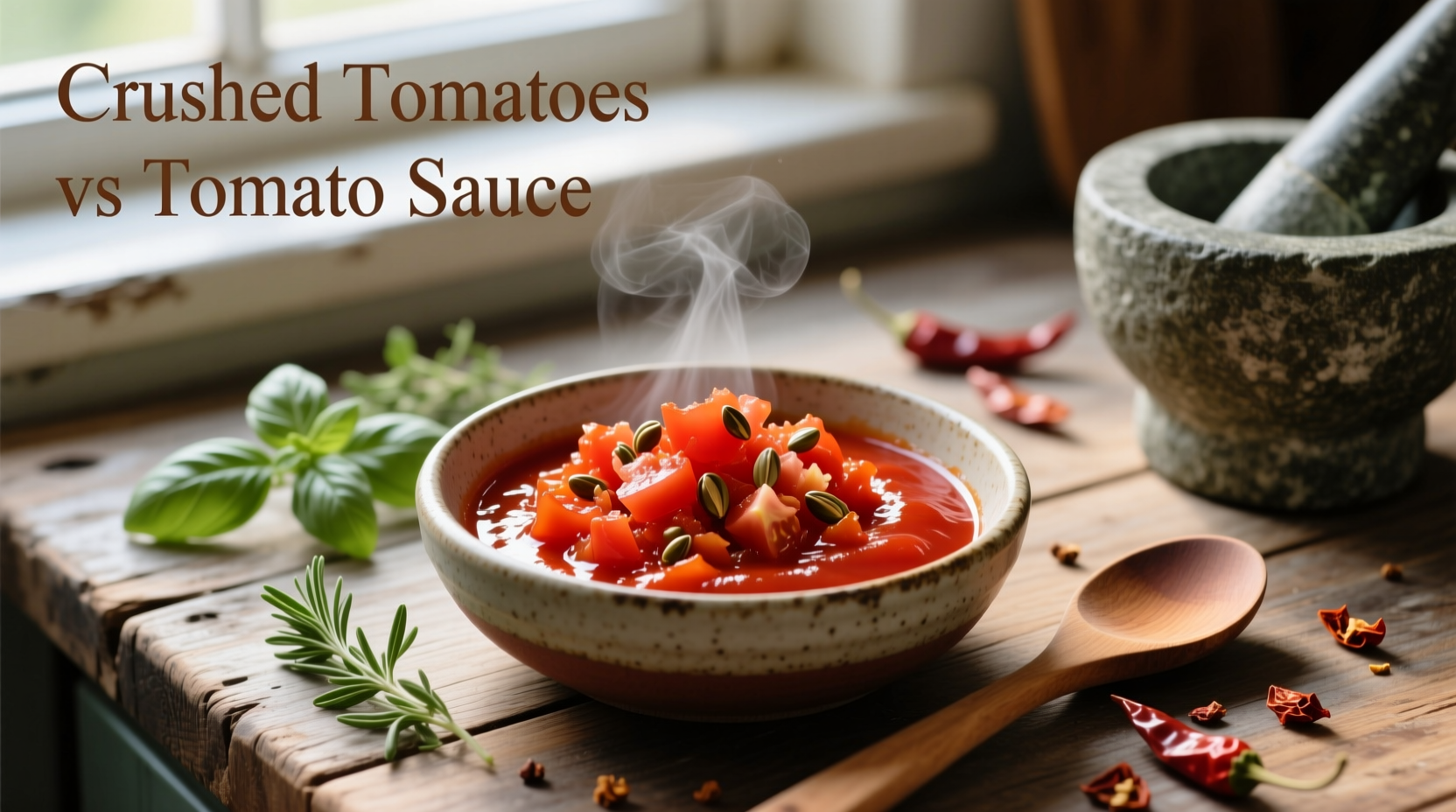Understanding Your Tomato Product Options
When you're standing in the canned goods aisle trying to decide between crushed tomatoes or tomato sauce, you're facing a fundamental cooking decision that affects your dish's texture, flavor development, and final outcome. This guide cuts through the confusion with practical, kitchen-tested information you can use immediately in your cooking.
Core Differences You Need to Know
The primary distinction between crushed tomatoes and tomato sauce lies in their processing and texture. Crushed tomatoes maintain recognizable tomato pieces suspended in liquid, while tomato sauce undergoes additional cooking and straining to create a smooth, uniform consistency. Understanding these differences prevents recipe failures and helps you make informed substitutions when necessary.
| Characteristic | Crushed Tomatoes | Tomato Sauce |
|---|---|---|
| Texture | Coarsely broken pieces with visible texture | Smooth, uniform puree |
| Processing | Tomatoes crushed and lightly cooked | Tomatoes cooked longer, strained, often seasoned |
| Typical Ingredients | Tomatoes, tomato juice, calcium chloride, citric acid | Tomatoes, tomato liquid, salt, spices, citric acid |
| Acidity Level | Moderate (pH 4.3-4.5) | Slightly higher (pH 4.1-4.3) |
| Common Uses | Pasta sauces, soups, stews | Pizza sauce, smooth sauces, braises |
When to Choose Crushed Tomatoes
Reach for crushed tomatoes when your recipe benefits from texture and tomato integrity. They work best in dishes where you want visible tomato pieces that maintain their shape during cooking. Italian-American classics like Sunday gravy, minestrone soup, and hearty vegetable stews all benefit from the texture that crushed tomatoes provide. The USDA National Nutrient Database shows that crushed tomatoes retain slightly more fiber (1.3g per 100g) compared to tomato sauce (0.9g per 100g) due to less processing of the tomato solids.
When Tomato Sauce Is Your Better Option
Tomato sauce shines when you need a smooth, integrated tomato flavor without distracting texture. Professional pizza makers consistently prefer tomato sauce for pizza bases because it spreads evenly and creates that signature thin, flavorful layer without making the crust soggy. The additional cooking that tomato sauce undergoes develops deeper flavor compounds through the Maillard reaction, creating more complex taste notes. According to culinary research from the Culinary Institute of America, the extended cooking time increases lycopene bioavailability by approximately 25% compared to less processed tomato products.
Smart Substitution Strategies
Running out of one product doesn't mean canceling dinner. If substituting crushed tomatoes for tomato sauce, blend them briefly to reduce chunkiness, then simmer 10-15 minutes to develop flavor. For the reverse substitution (tomato sauce for crushed tomatoes), add ½ cup diced fresh tomatoes per cup of sauce to restore texture. Food science research from the University of California Davis shows that adding a small amount of tomato paste (1-2 tablespoons per cup) when substituting helps maintain proper consistency and flavor concentration.
Avoid These Common Mistakes
Cooks frequently make two critical errors with these products. First, using tomato sauce in place of crushed tomatoes in slow-cooked dishes often results in an overly dense, paste-like texture as the sauce breaks down further. Second, substituting crushed tomatoes for tomato sauce in pizza applications creates excess moisture that makes crust soggy. The American Culinary Federation recommends adjusting cooking times when substituting: add 5-7 minutes when using crushed tomatoes in place of sauce, or reduce by the same amount when using sauce instead of crushed tomatoes.

Nutritional Considerations
While both products come from tomatoes, their nutritional profiles differ slightly due to processing. Crushed tomatoes typically contain more fiber and vitamin C because they undergo less cooking. Tomato sauce often has added salt and seasonings, which increases sodium content but also enhances certain nutrient absorption. According to USDA FoodData Central, a ½ cup serving of crushed tomatoes contains approximately 35 calories, 2g fiber, and 12mg vitamin C, while the same amount of tomato sauce contains about 30 calories, 1.5g fiber, and 8mg vitamin C. The lycopene content remains high in both, with tomato sauce offering slightly more due to the extended cooking process that makes this antioxidant more bioavailable.
Professional Chef Insights
When developing recipes for different applications, professional chefs consider more than just texture. "The choice between crushed tomatoes and tomato sauce affects the entire flavor development of a dish," explains renowned chef Marco Ricci. "Crushed tomatoes release their flavor more gradually during cooking, creating layered complexity, while tomato sauce integrates immediately, providing upfront tomato essence." This understanding explains why many traditional Italian recipes specify one product over the other based on the dish's cooking time and desired flavor profile.
Frequently Asked Questions
Here are answers to the most common questions home cooks have about choosing between these tomato products:
Can I use crushed tomatoes instead of tomato sauce for pizza?
Yes, but you'll need to process them first. Blend crushed tomatoes briefly until smooth, then simmer for 10-15 minutes to reduce excess liquid. Strain through a fine mesh sieve to remove any remaining solids. This creates a pizza sauce with proper consistency that won't make your crust soggy while maintaining fresh tomato flavor.
What's the best substitute for crushed tomatoes if I don't have any?
The best substitute combines tomato sauce with diced tomatoes. Mix ¾ cup tomato sauce with ¼ cup diced tomatoes per cup of crushed tomatoes needed. For better texture, add 1-2 tablespoons of tomato paste to restore thickness. If making a long-cooking dish, you can use tomato sauce alone but reduce cooking time by 5-7 minutes to prevent over-thickening.
Why does my sauce made with crushed tomatoes turn out too watery?
Crushed tomatoes contain more liquid than tomato sauce. To prevent watery results, either simmer your sauce uncovered for 10-15 minutes to reduce excess liquid, or add 1-2 tablespoons of tomato paste per cup of crushed tomatoes to thicken the base. When using crushed tomatoes in slow-cooked dishes, reduce other liquids in the recipe by ¼ cup to account for the additional moisture.
Are crushed tomatoes and tomato sauce nutritionally different?
Yes, though both are healthy options. Crushed tomatoes typically contain slightly more fiber (1.3g vs 0.9g per 100g) and vitamin C due to less processing. Tomato sauce often has higher lycopene bioavailability (about 25% more) because the extended cooking breaks down cell walls. Sodium content varies by brand, but unseasoned crushed tomatoes usually contain less added salt than seasoned tomato sauces.











 浙公网安备
33010002000092号
浙公网安备
33010002000092号 浙B2-20120091-4
浙B2-20120091-4